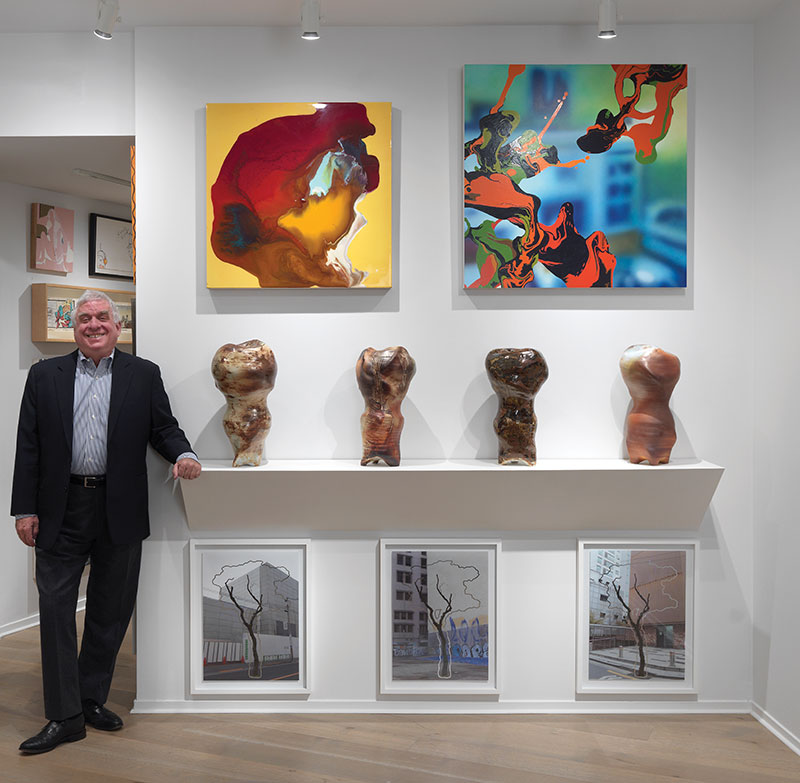The Art Dealer as Collector and Connector: William Lieberman

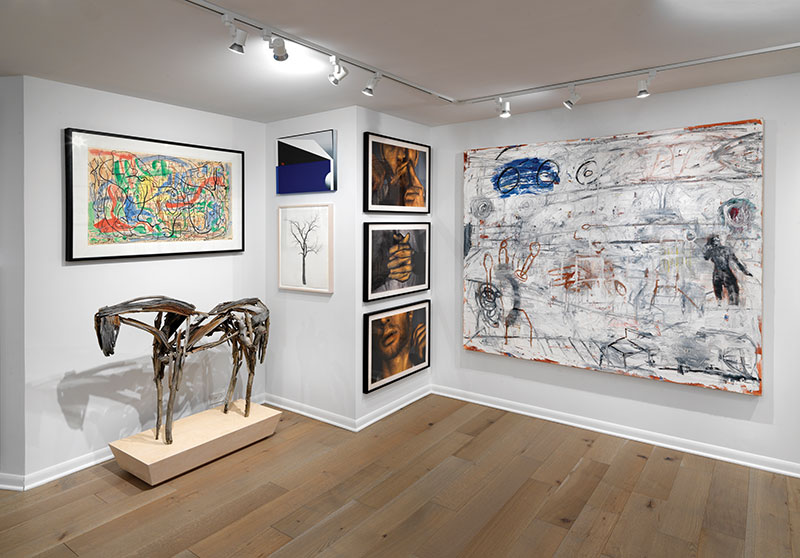
By GINNY VAN ALYEA
When I spent an afternoon this winter with William Lieberman, owner of Zolla/Lieberman Gallery, it was not to discuss his role as an art dealer. Instead, it was to see his personal collection, which he had recently installed in his new Streeterville condo overlooking Lake Michigan.
Lieberman had just moved from a house in East Ukrainian Village and was eager to highlight hundreds of works in a fresh setting. Taking in the abundantly-filled walls, I asked him how he chose the art that he lives with, knowing that every day at the gallery he strives to build other people’s collections. Lieberman shared that he began to collect art while studying studio pottery at Grand Valley State University in Grand Rapids, Michigan.
At first, Lieberman did what artists often do with their peers: he traded art. Trading helped him meet other artists, get to know their work, refine his own practice and, of course, learn to negotiate. After moving back to Chicago, he continued to develop both his pottery and trading skills in Northeastern Illinois University’s ceramic studio.
Art collecting is a highly personal pursuit, undertaken with as much emotional as financial investment. Collectors can spend years acquiring and curating their collections which hold personal meaning as well as reflect their particular tastes. Some may have significant cultural and historic value, and provide a window to the evolution of artistic movements.
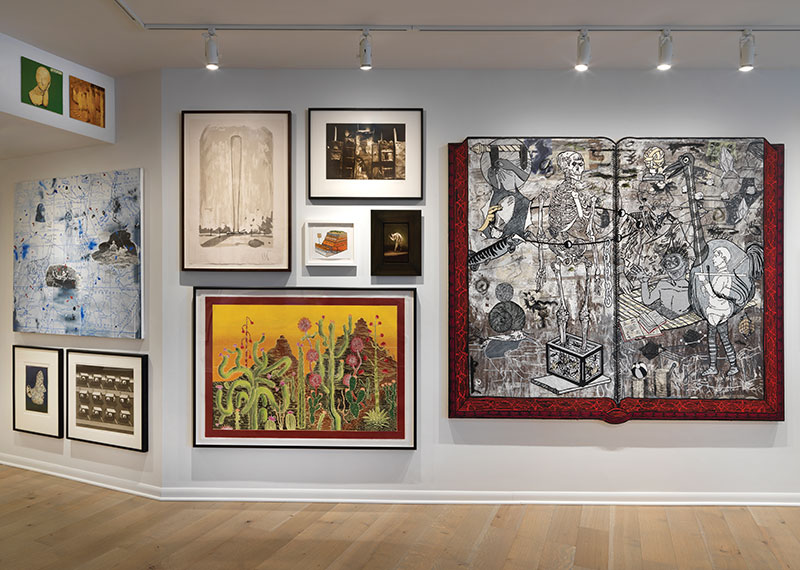
In Lieberman’s case, he grew up surrounded by art. While he was a college student, his mother Roberta Lieberman, together with Robert Zolla, opened a contemporary gallery in 1976 that specialized in paintings, drawings and sculpture. Three years later, while still intent on becoming a professional potter, he began working part-time at the gallery.
By the 1980s, Lieberman worked at the gallery full time, although some of his compensation came in the form of art. His mother and Zolla would have him pick a piece, pay the artist as much as if it had sold, and forgo the gallery’s portion. Not only did this practice support individual artists, it also allowed Lieberman to start his collection and refine his own eye. Later, he began to make yearly trips to New York, where he stayed with artists, fed himself on the gallery’s $25 per diem, and “pounded the pavement” as he went to studios, galleries and museums.
Gradually, Lieberman built a personal, thoughtful and carefully acquired collection. It would not, however, last very long. On April 1, 1989, he stored his entire collection at the gallery while he moved from one apartment to another. On April 15, the building on Huron Street, housing Z/L and many other galleries, burned to the ground. Though works by artists such as Susanne Doremus, David Nash and Michael Nakoneczny could never be replaced, some offered pieces to Lieberman to begin a new collection.
With insurance money that he received, Lieberman bought a 1,400-square foot house in 1990 and, as he recalls, “I started to buy a lot of art. Nothing too expensive but I started over.”
Hanging works vertically, salon style, he quickly filled his home. He commissioned Paul Coffey to paint a mural on the 35-foot high atrium over the dining area. The six-month project used Rand McNally map color schemes to depict an ambiguous location in Ireland. The mural even incorporated the atrium skylight. Over time, Lieberman’s home became an inviting artistic destination, serving as a bridge between white exhibition walls and a residential setting. “I brought people to see how I lived in East Ukrainian Village,” he explains, “and they liked the environment that I created.” As his life at work and at home continued to meld, he hosted dinners to promote gallery artists like Deborah Butterfield, John Buck, Josh Garber and Jay Strommen. A few times, says Lieberman, he had as many as 50 guests, with four Weber grills going in the backyard and people enjoying their meal in every room of the house.
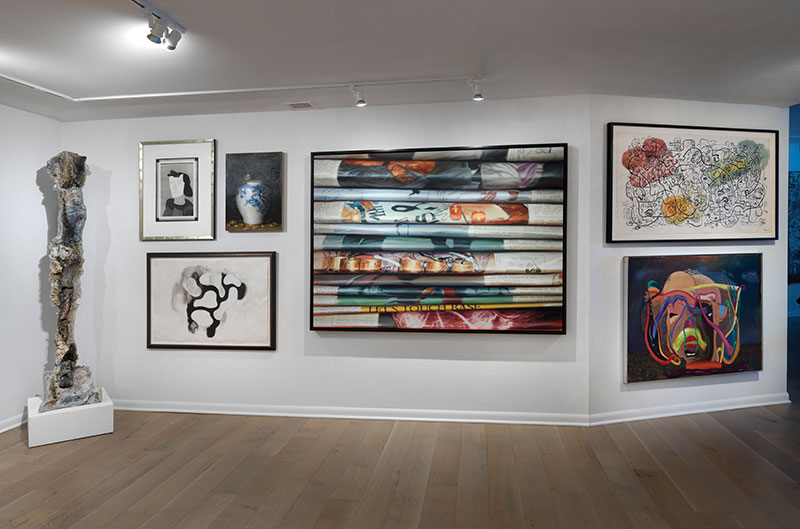
Following these dinners, clients often bought or commissioned art, though Lieberman emphasizes that he never sells pieces from his personal collection. Lieberman actually found his current condo thanks to a client relationship that emerged from gatherings in the East Ukrainian Village house. When collector Anne Finkelman learned that a unit in her building was up for sale, she passed the tip along to Lieberman who made a swift decision to buy it.
The move from a house to a condo meant leaving behind site-specific and other large-scale pieces. However, the new space is more than twice as big (3,000 square feet) and many works have found a new pride of place. Collector and friend Arlene Richman gifted Claes Oldenburg’s Bat Spinning at the Speed of Light, published by Landfall Press, to William for his 60th birthday. Oldenburg’s 100-ft. tall sculpture has graced Chicago’s skyline since 1977 and, given William’s love of softball and baseball, Richman says she delights in seeing this print now prominently displayed.
Lieberman does not have lot of furniture in his new home yet, and the clutter from living in one place for years hasn’t taken hold, but the presence of so many vibrant works of art imbues the condo with a lived-in feel. The placement of several sculptures of varying scale also add levels of dimension, including two by Butterfield, one cast bronze and the other welded copper, indicative of Lieberman and Butterfield’s 45 years of working together.
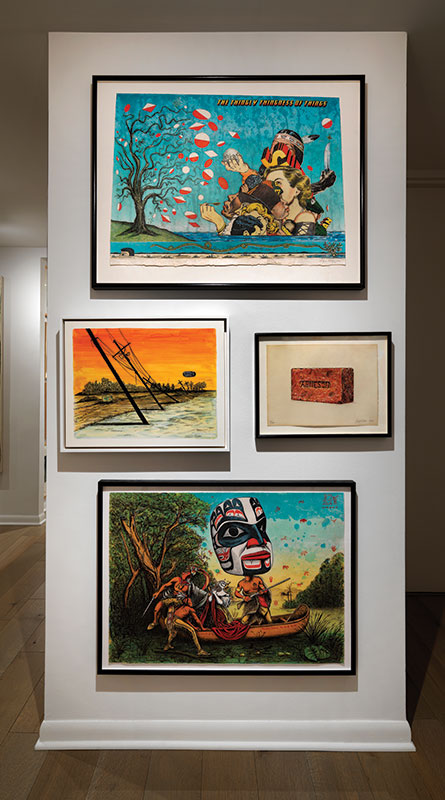
A row of painted Artforum covers by artist Conrad Bakker, bordering a doorway, speaks to Brian Gillham’s role in finding just the right place for each work of art in Lieberman’s collection as well as in the gallery. At home he applied his signature skill of bringing order to chaos, singlehandedly rehanging the entire collection. Gillham has worked for Z/L since 2004. “Brian didn’t guess,” says Lieberman when asked about the Artforum covers and other groupings. Discerning ties between concepts – from Herman Aguirre’s paintings to Jay Strommen’s ceramics – and taping out arrangements on the floor, Gillham placed works without disrupting the charm and affection that they generate as a whole.
Lieberman has already begun to plan for the future, as Nathan Kemler, Director of Galleries and Collections at Grand Valley State University, points out. “William works endlessly to maximize the role of art in our lives and has enabled us to acquire an incredible contemporary collection to share with our community.” Among many contributions to his alma mater, Lieberman has promised GVSU – which awarded him an honorary doctorate in 2014 – the gift of his ceramic vessels, platters, teapots and sculpture.
Often after decades of buying art, a collector slows down. So far, Lieberman has not taken his foot off the pedal and doesn’t want to part with anything that gives him so much comfort and joy. Recently, he says that he’s been prompted to buy more. “It diversifies my collection as well as ensuring that it has a higher level of museum quality. And as far as my relationships with artists, it helps that I continue to invest and believe in their work. It’s my life.”
